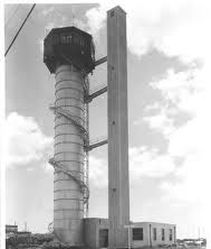 Escape training tank, Google Image
Escape training tank, Google Image The tower on the left is the submarine escape tank. I think this is the one in New London but I am not sure. There was another at Pearl Harbor. The tower on the right is an elevator. The tank had heights of 50 and 100 feet. We had to prove we could escape from the depth of 50' if I remember correctly.
First we were put through a simple pressure chamber. We were loaded into it in bathing suits. It was pressurized and things got very warm. We proved we could handle the pressure without rupturing something important (at the time it was all important). Then they let off the pressure. If our nose or ears started bleeding we were shipped off to sick bay. If not, this tower was next.
We took the elevator up to 50 feet from the top. We loaded into a pressure tank with doors on both ends. They shut the doors, let some water flood in and equalized the pressure to the water pressure in the tank. Open the door and blow and go.
Divers would punch us in the stomach all the way to the top if we forgot to go ho ho ho inside the little hood we had to wear. That kept us from having embolisms.
In 1968 a strange thing happened. The tower was put out of commission by a fire. We took a trip that wound up in England and the Scorpion was lost the day we got into port. Since escaping from a wounded sub was suddenly of paramount importance I got a chance to see how the British did it. They had a full suit instead of a little hood like ours. They also, therefore, had a better chance of survival.
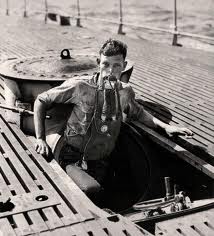
It gave the ships corpsman a pressure chamber if there was a diving accident. It also allowed you to offload swimmers in certain operations which may or may not have ever happened.
The escape tank got you ready for this and screened out folks who couldn't stand the pressure of close spaces. More about that later.
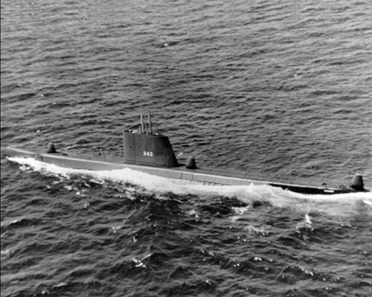 USS Clamagore SS343 - Google Image
USS Clamagore SS343 - Google Image This was my first boat, the USS Clamagore (SS343).
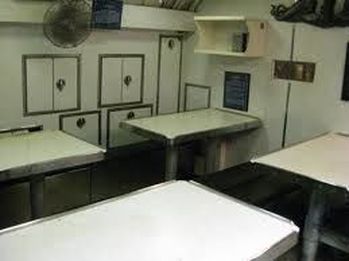 Crews Mess, USS Clamagore - Google Image
Crews Mess, USS Clamagore - Google Image I remember this mess as being stainless steel but the Clamagore is now a museum boat and pretty soon I understand it’s going to become an artificial reef. Things change.
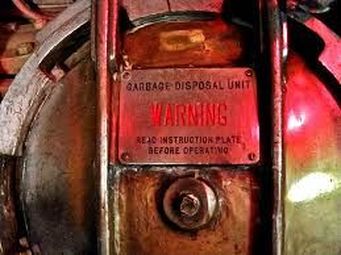 Garbage Disposal Unit - Google Image
Garbage Disposal Unit - Google Image There is a bag that looks like a sock that one loads with trash. It has a weight in the bottom. Once the unit is loaded, the pressures are equalized, the outer doors are open and the stuff falls out. If I remember correctly water is pumped through to flush the tube clean. Water because an air blast is too noisy and you never make unnecessary noise if you can help it.
The weighted garbage falls to the bottom and over time the bag will deteriorate. Fish consume the whole mess except the metal weight one supposes.
Cardboard and plastic do not routinely make that trip. Cardboard can be weighted and thrown over the side when we are on the surface but I mostly remember it being saved in the spaces outboard the bunks till we hit port.
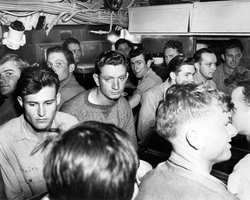 Crews Mess, USS Tambor, WW2
Crews Mess, USS Tambor, WW2 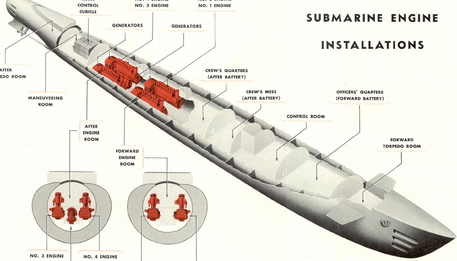 Typical Submarine - Google Images
Typical Submarine - Google Images 
http://www.curbsideclassic.com/dockside-classic/diesel-electric-submarines-worlds-biggest-hybrids/
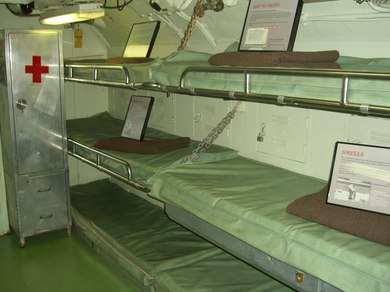 Hogans Alley, USS Clamagore - Google Image
Hogans Alley, USS Clamagore - Google Image The bunks with the pipe railings had springs and in real life before it was a museum boat there were four bunks on the inner bulkhead. However I crawled into bed was how I slept. No room to sleep on the side or turn over.
When we loaded for a long patrol the deck you see here was loaded with boxes of food. Always cans so we could walk on them. There were also cases of food loaded into each bunk. Move them when you turned in.
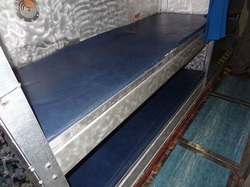 Probably an after battery bunk, someone's sub Google Image
Probably an after battery bunk, someone's sub Google Image 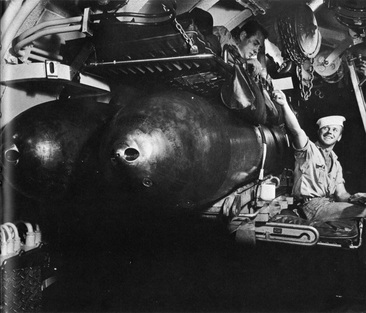 Torpedo Room Bunks - typical Diesel Electric - Google Image
Torpedo Room Bunks - typical Diesel Electric - Google Image Torpedo Room Bunks Some bunks and berthing areas were more spartan than others. I think these are conventional torpedoes. They slept on the Nuclear ones the same way.
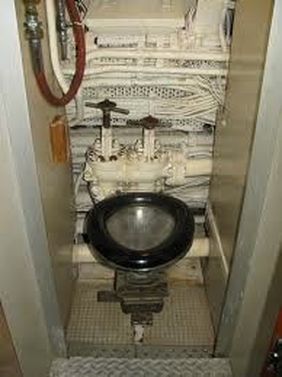 Google Image
Google Image Using this toilet was fairly simple. Blowing the sanitary tank was not. Not knowing what you were doing could be very smelly and dangerous.
Something bad happened to a young fellow I met on the sailfish. He enlisted for subs but was claustrophobic. We picked him up in Pearl and went to Japan.
He had not been screened out by the escape tank. He had to be offloaded in Japan and blew some contents of one of these all over his uniform as his last official act. Bon Voyage.
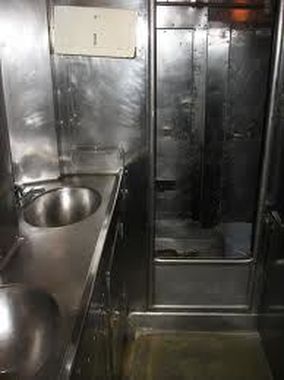 Google Image
Google Image Underway we pulled the potatoes and opened the showers every ten days. You had to save water so there was a valve that allowed you to turn it off after you set your hot and cold mixture.
The routine was to set the mixture of hot/cold, get wet, turn it off, soap down, and rinse it off. I still cannot make myself take a long shower unless I have a batch of aches and pains.
The Nucs have 10 times the capacity to make water and unlimited power to do it.
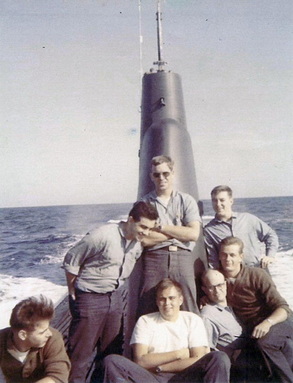 Air bath by forward Puffs
Air bath by forward Puffs That’s why air baths became so important. This is not a google picture and two of the names have been lost to me but I remember them all.
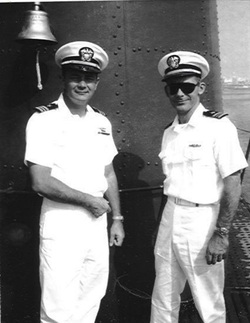 Google Image
Google Image The officer on the left is Captain D.M. Ulmer who was the skipper. The XO was Commander J.R. Spear. Their jobs were to see that all this ran smoothly. Great officers.
I reported directly to the XO most of the time. Captain Ulmer had a very busy day seeing that his ship didn’t run aground or create an international incident. He was realistically too busy to bother on routine matters.
When someone was sick one of these men would talk to me. Otherwise I was pretty much of the opinion that I should stay out of their way and do my job. When I went to see them it was always important. That is an attitude I carried forth into civilian life. Sometimes that was good, sometimes bad. Some of those important times I had to see them actually quickly became routine.
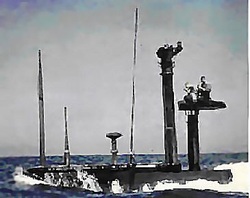 Submarine Snorkel Google Image
Submarine Snorkel Google Image This appears to be a Nuclear Boat sail so who knows whats going on. They seldom snorkel.
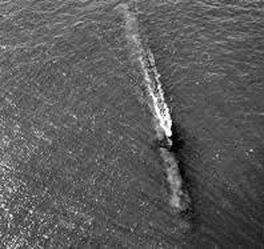 Sub snorkeling/Google Image
Sub snorkeling/Google Image I can no longer find the pictures of the ancient CO2 analyzer I used. Didn’t matter much. The smokers would tell me it was time. Their cigarettes wouldn’t stay lit. Choices then were to snorkel or scrub the CO2 and bleed some air from the compressed air banks. I know it sounds like I'm saying I was a "big deal" here but not really. Like everything else in subs, it was a team effort. 5 minutes of snorkeling made things much better and took the place of a lot of work. Sometimes we just couldn’t snorkel because we dare not be seen.
If it had to do with health the corpsman was involved. Best job I ever had but the potential was there to be busy.
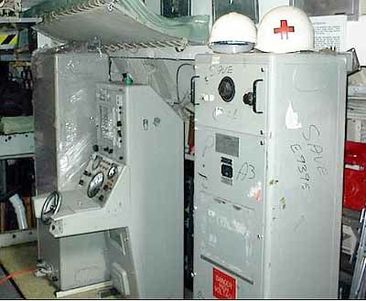 Google Image
Google Image By the time I left the Clamagore I was a watch supervisor and really wasn't able to do that on my next boat.
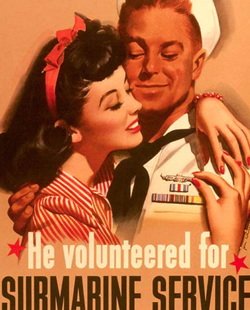 Google Image
Google Image That insignia she is touching is for completed war patrols. I knew several submariners who wore them that were still kicking around in 1966-1970 while I was riding the boats. I guess they would all be pushing 90 if alive today.
More things may show up here when I think of them. If you enjoyed the read, check back.
 RSS Feed
RSS Feed